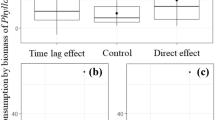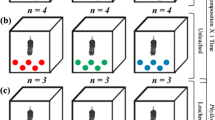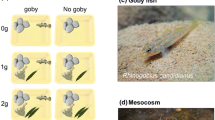Abstract
We evaluated the effect of predation risk for larvae of Phylloicus (Trichoptera: Calamoceratidae) on leaf-litter consumption and case-building in experimental microcosms performing three Brazilian biomes: Amazon Forest, Atlantic Rainforest, and Brazilian Savanna (Cerrado). We hypothesized the following: (1) predation risk by fish would decrease the feeding rate but increase the sheltering activities of Phylloicus larvae, mainly in a high-stimulus treatment (visual and chemical cues from predators’ presence); and (2) when offered a resource with the same palatability, leaf consumption by Phylloicus larvae from Amazon Forest and Atlantic Rainforest will be higher than in those from the Savanna, independent of the predation risk. We found that larvae of Phylloicus species from the three biomes use the leaf disks in different proportions for case-building and consumption: Amazon Forest (case-building = 44% and consumption = 50%), Atlantic Rain Forest (60% and 36%), and Brazilian Savanna (32% and 26%). The larvae case-building and leaf consumption by Phylloicus were higher under predation than in the control treatment using data uncorrected by the biomass of the individual. On the other hand, case-building was not different among all treatments, and leaf consumption was lower under predation than in the control treatment when corrected by biomass. Our results indicate that predation risk can affect the behavior of Phylloicus due to a stress response to predator presence. Therefore, it might mean top-down effects on shredders during leaf-litter processing in Neotropical headwater streams. Besides, insectivorous fish could be the key group for functioning in these ecosystems.



Similar content being viewed by others
Data availability
The authors declare that the data are available.
References
Aguiar ACF, Neres-Lima V, Moulton TP (2017) Relationships of shredders, leaf processing and organic matter along a canopy cover gradient in tropical streams. J Limnol. https://doi.org/10.4081/jlimnol.2017.1684
Alvim EACC, Medeiros AO, Rezende RS, Gonçalves JF Jr (2015) Leaf breakdown in a natural open tropical stream. J Limnol 74:248–260. https://doi.org/10.4081/jlimnol.2014.982
Beckerman AP, Wieski K, Baird DJ (2007) Behavioural versus physiological mediation of life history under predation risk. Oecologia 152:335–343. https://doi.org/10.1007/s00442-006-0642-6
Boyero L, Rincón PA, Bosch J (2006) Case selection by a limnephilid caddisfly [Potamophylax latipennis (Curtis)] in response to different predators. Behav Ecol Soc 59:364–372
Boyero L, Rincón PA, Pearson RG (2008) Effects of a predatory fish on a tropical detritus-based food web. Ecol Res 23:649–655
Boyero L, Pearson RG, Dudgeon D, Graça MAS, Gessner MO, Albariño RJ et al (2011) Global distribution of a key trophic guild contrasts with common latitudinal diversity patterns. Ecology 92:1839–1848. https://doi.org/10.1890/10-2244.1
Boyero L, López-Rojo N, Tonin AM, Pérez J, Correa-Araneda F, Pearson RG, Bosch J et al (2021) Impacts of detritivore diversity loss on instream decomposition are greatest in the tropics. Nat Commun 12:1–11
Charmandari E, Tsigos C, Chrousos G (2005) Endocrinology of the stress response. Ann Rev Phys 67:259–284
Crawley MJ (2012) The R book. Wiley, West Sussex
Dunoyer L, Dijoux L, Bollache L, Lagrue C (2014) Effects of crayfish on leaf litter breakdown and shredder prey: are native and introduced species functionally redundant? Biol Inv 16:1545–1555
Ferreira WR, Paiva LT, Callisto M (2011) Development of a benthic multimetric index for biomonitoring of a neotropical watershed. Braz J Biol 71:15–25
Ferreira WR, Ligeiro R, Macedo DR, Hughes RM, Kaufmann PR, Oliveira LG, Callisto M (2015) Is the diet of a typical shredder related to the physical habitat of headwater streams in the Brazilian Cerrado? Ann Limnol 51:115–127
Gomes PP, Medeiros AO, Gonçalves JF Jr (2016) The replacement of native plants by exotic species may affect the colonization and reproduction of aquatic hyphomycetes. Limnologica 59:124–130
Gonçalves JF Jr, Couceiro SRM, Rezende RS, Martins RT, Ottoni-Boldrini BMP et al (2017) Factors controlling leaf litter breakdown in Amazonian streams. Hydrobiologia 792:195–207
Gonçalves JF Jr, Rezende RS, Martins NM, Gregório RS (2012) Leaf breakdown in an Atlantic Rain Forest stream. Aust Ecol 37:807–815
Graça MAS (2001) The role of invertebrates on leaf litter decomposition in streams - a review. Int Rev Hydrobiol 86:383–393
Guarçoni EA, Paula CC, Costa AF (2010) Bromeliaceae do Parque Estadual da Serra do Rola-Moça, Minas Gerais. Rodriguésia-Instituto De Pesquisas Jardim Botânico Do Rio De Janeiro 61:467–490
Hawlena D, Schmitz OJ (2010) Physiological stress as a fundamental mechanism linking predation to ecosystem functioning. Am Nat 176:537–556
Holzenthal RW, Calor AR (2017) Catalog of the Neotropical Trichoptera (Caddisflies). ZooKeys 654:1–566
IBGE – Instituto Brasileiro de Geografia e Estatística. Mapas de Biomas e de Vegetação. Available at: https://ww2.ibge.gov.br/home/presidencia/noticias/21052004biomashtml.shtm. Accessed: February 27, 2018
Kohler SL, McPeek MA (1989) Predation risk and the foraging behavior of competing stream insects. Ecology 70:1811–1825
Leroux S, Loreau M (2015) Theoretical perspectives on bottom-up and top-down interactions across ecosystems. In: Hanley T, La Pierre K (eds) Trophic ecology: bottom-up and top-down interactions across aquatic and terrestrial systems (Ecological Reviews). Cambridge University Press, Cambridge, pp 3–27
Li AOY, Dudgeon D (2008) Food resources of shredders and other benthic macroinvertebrates in relation to shading conditions in tropical Hong Kong streams. Fresw Biol 53:2011–2025
Lima SL (1998) Nonlethal effects in the ecology of predator-prey interactions. Bioscience 48:25–34
Martins RT, Melo AS, Gonçalves JF Jr, Campos CM, Hamada N (2017a) Effects of climate change on leaf breakdown by microorganisms and the shredder Phylloicus elektoros (Trichoptera: Calamoceratidae). Hydrobiologia 789:31–44
Martins RT, Rezende RS, Gonçalves JF Jr, Lopes A, Piedade MTF, Cavalcante HL, Hamada N (2017b) Effects of increasing temperature and CO2 on quality of litter, shredders, and microorganisms in Amazonian aquatic systems. PLos One 12:e0188791. https://doi.org/10.1371/journal.pone.0188791
McIntosh A, Peckarsky B (1996) Differential behavioural responses of mayflies from streams with and without fish to trout odour. Freshw Biol 35:141–148
Mendonça FP, Magnusson WE, Zuanon J (2005) Relationships between habitat characteristics and fish assemblages in small streams of Central Amazonia. Copeia 4:750–763
Meyer ST, Silva AF, Júnior PM, Meira-Neto JAA (2004) Composição florística da vegetação arbórea de um trecho de floresta de galeria do Parque Estadual do Rola-Moça na Região Metropolitana de Belo Horizonte, MG, Brasil. Act Bot Bras 18:701–709
Navarro FKSP, Gonçalves JF Jr (2017) Effect of leaf decomposition stage and water temperature on fragmentation activity of a shredder invertebrate species in lotic ecosystems. Iheringia Ser Zool 107:e2017017. https://doi.org/10.1590/1678-4766e2017017
Navarro FKSP, Rezende RS, Gonçalves JF Jr (2013) Experimental assessment of temperature increase and presence of predator carcass changing the response of invertebrate shredders. Biot Neot 13:28–33
R Core Team (2017) A language and environment for statistical computing. R Foundation for Statistical Computing, Vienna. http://www.rproject.org
Raffard A, Cucherousset J, Montoya JM, Richard M, Acoca-Pidolle S, Poésy C et al (2021) Intraspecific diversity loss in a predator species alters prey community structure and ecosystem functions. PLoS Biol 19(3):e3001145
Rezende RS, Petrucio MM, Gonçalves JF Jr (2014) The effects of spatial scale on breakdown of leaves in a tropical watershed. PLos One 9:1–12
Rezende RS, Leite GFM, De-Lima AKS, Silva-Filho LAB, Chaves CVC, Prette ACH (2015) Effects of density and predation risk on leaf litter processing by Phylloicus sp. Aus Ecol 40:693–700
Rezende RS, Bernardi JP, Gomes ES et al (2021) Effects of Phylloicus case removal on consumption of leaf litter from two Neotropical biomes (Amazon rainforest and Cerrado savanna). Limnologia 22:35–42. https://doi.org/10.1007/s10201-020-00628-w
Ripple WJ, Estes JA, Schmitz OJ, Constant V, Kaylor MJ, Lenz A, Motley JL, Self KE (2016) What is a trophic cascade? Trends Ecol Evol 31:842–849
Rodgers GM, Downing B, Morrell LJ (2015) Prey body size mediates the predation risk associated with being “odd.” Behav Ecol 26:242–246
Rodríguez-Lozano P, Verkaik I, Maceda-Veiga A, Monroy M, Sostoa A, Rieradevall M, Prat N (2016) A trait-based approach reveals the feeding selectivity of a small endangered Mediterranean fish. Ecol Evol 6:3299–3310
Romero GQ, Moi DA, Nash LN, Antiqueira PA, Mormul RP, Kratina P (2021) Pervasive decline of subtropical aquatic insects over 20 years driven by water transparency, non-native fish and stoichiometric imbalance. Biol Lett 17(6):20210137
Schmitz OJ, Hawlena D, Trussell GC (2010) Predator control of ecosystem nutrient dynamics. Ecol Lett 13:1199–1209
Sena G, Júnior JFG, Martins RT et al (2020) Leaf litter quality drives the feeding by invertebrate shredders in tropical streams. Ecol Evol 10:8563–8570. https://doi.org/10.1002/ece3.6169
Senna LM (1984) Maprounea Aubl. (Euphorbiaceae). Considerações taxonômicas e anatômicas das espécies Sul-Americanas. Rodriguésia 36:51–78
Shah AA, Woods HA, Havird JC, Encalada AC, Flecker AS, Funk WC, Guayasamin JM et al (2020) Temperature-dependence of metabolic rate in tropical and temperate aquatic insect: support for the climate variability hypothesis in mayflies but not stoneflies. Glob Change Biol. https://doi.org/10.1111/gcb.15400
Strassburg BBN, Brooks T, Feltran-Barbieri R, Iribarrem A, Crouzeilles R, Loyola R et al (2017) Moment of truth for the Cerrado hotspot. Nat Ecol Evol 1:0099. https://doi.org/10.1038/s415559-017-0099
Tank JL, Rosi-Marshall EJ, Griffiths NA, Entrekin SA, Stephen ML (2010) A review of allochthonous organic matter dynamics and metabolism in streams. J North Am Benth Soc 29:118–146
Tonin AM, Hepp LU, Restello RM, Gonçalves JF Jr (2014) Understanding of colonization and breakdown of leaves by invertebrates in a tropical stream is enhanced by using biomass as well as count data. Hydrobiologia 740:79–88
Tonin AM, Gonçalves JF Jr, Bambi P, Couceiro SRM, Feitoza LAM, Fontana LE et al (2017) Plant litter dynamics in the forest-stream interface: precipitation is a major control across tropical biomes. Sci Rep 7:10799. https://doi.org/10.1038/s41598-017-10576-8
Wantzen KM, Rosa FR, Neves CO, Cunha CN (2005) Leaf litter addition experiments in riparian ponds with different connectivity to a Cerrado stream in Mato Grosso, Brazil. Amazoniana 18:387–396
Wittmer HU, Serrouya R, Elbroch LM, Marshall AJ (2013) Conservation strategies for species affected by apparent competition. Conserv Biol 27:254–260
Acknowledgements
A Post-doctoral fellowship was awarded to WRF by Brazil’s Conselho Nacional de Desenvolvimento Científico e Tecnológico (CNPq, Process 150105/2017-7). We are grateful for funding from Pesquisa & Desenvolvimento/Agência Nacional de Energia Elétrica/Companhia Energética de Minas Gerais-P&D ANEEL/CEMIG GT-487 and GT-599, and support from the Coordenação de Aperfeiçoamento de Pessoal de Nível Superior (CAPES), and Fundação de Amparo à Pesquisa do Estado de Minas Gerais (FAPEMIG). MC is a CNPq productivity fellow (Nº. 304060/2020-8). We thank our colleagues in the Laboratório de Ecologia de Bentos for their support in the field. The Program Ecologia, Conservação e Manejo de Vida Silvestre of Federal University of Minas Gerais (ECMVS/UFMG), Instituto Estadual de Floresta (IEF) kindly granted the license for the collection of organisms (Nº 050/2015). We thank the team of Parque Estadual da Serra do Rola Moça—Minas Gerais for their support (Marcus Vinícius, Carolina Alvarenga, Flávia Castro, and Felipe Braga). We thank Sistema de Autorização e Informação em Biodiversidade (SISBIO) for the permanent license for the collection of zoological material (Nº 10635). Professor Adolfo Calor, of the Federal University of Bahia (UFBA), helped identify the species Phylloicus angustior, and our colleague Carlos Bernardo M. Alves helped identifying the species Astyanax rivularis. Eliane Solar graciously aided in the sampling and in carrying out the experiments in the laboratory of the National Institute of Amazonian Research (INPA/AM). RTM received a fellowship from Programa Nacional de Pós-Doutorado (PNPD/CAPES) and the Programa de Apoio à Fixação de Doutores no Amazonas—FIXAM/AM (FAPEAM). NH received a research fellowship from CNPq (308970/2019-5). The FAPEAM funded field sampling and laboratory experimentation in the Amazon- POSGRAD program and by INCT ADAPTA II, which is funded by CNPq – Brazilian National Research Council (465540/2014-7), FAPEAM – Amazonas State Research Foundation (062.1187/2017), and CAPES–Coordination for the Improvement of Higher Education Personnel. RSR is grateful to CNPq and the Chico Mendes Institute for Conservation of Biodiversity (ICMBio; project numbers 421288/2017-5 and 405290/ 2018-7). JFGJR supported by CNPq through research fellowships (310641/2017-9), Fundação de Amparo à Pesquisa do Distrito Federal through Edital universal (Nº 193.000.870/2015) and Edital 05/2016-Águas (Nº 193.000716/2016) and FINATEC-DPP/UnB-01/2017. We thank the Laboratório de Limnologia/AquaRiparia (Universidade de Brasília—UNB) for supporting data collection and laboratory analyses. We thank Philip M. Fearnside for his support with the English version.
Author information
Authors and Affiliations
Corresponding author
Ethics declarations
Conflict-of-interest
The authors declare that they have no competing interests.
Additional information
Publisher's Note
Springer Nature remains neutral with regard to jurisdictional claims in published maps and institutional affiliations.
All authors certify that they have seen and approved the final version of the manuscript being submitted. They warrant that the article is the author's original work, has not been previously published, and is not under consideration for publication elsewhere. The authors have no financial or non-financial interests directly or indirectly related to the work submitted for publication.
Rights and permissions
Springer Nature or its licensor (e.g. a society or other partner) holds exclusive rights to this article under a publishing agreement with the author(s) or other rightsholder(s); author self-archiving of the accepted manuscript version of this article is solely governed by the terms of such publishing agreement and applicable law.
About this article
Cite this article
Ferreira, W.R., Souza Rezende, R.d., Martins, R.T. et al. Effects of predation risk on invertebrate leaf-litter shredders in headwater streams in three Brazilian biomes. Aquat Sci 85, 28 (2023). https://doi.org/10.1007/s00027-022-00927-7
Received:
Accepted:
Published:
DOI: https://doi.org/10.1007/s00027-022-00927-7




